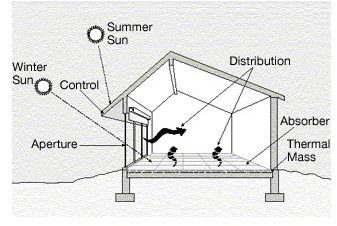Geothermal Solar Systems for Heating and Cooling
Energy efficiency and alternative energy sources are increasingly important in the face of global climate change and high energy costs. Building and retrofitting homes for alternative energy reduces the consumption of non-renewable energy sources and provides advantages for homeowners in reduced energy costs. Making responsible choices today translates into energy savings in the future.
Alternative Energy for Homes
Energy smart homes can make use of multiple methods of efficiency and alternative energy, from super insulation and efficient appliances to tapping alternative energy such as solar and geothermal sources. Regardless of the other methods used, the most efficient homes have one thing in common, and that is that they maximize passive performance before any mechanical conditioning systems are in place. With the right designs, much of a home’s heating and cooling needs can be met passively. However, in most climates additional heating or cooling systems are necessary.
Geothermal heat pumps are ideal heating and cooling systems for passive solar homes because they integrate well with passive designs. Additionally, with energy savings gained through passive design strategies, geothermal systems can be much smaller, therefore more affordable than in traditional homes.
Passive Solar Homes
Passive solar design is fundamental for energy efficient homes and can significantly reduce heating and cooling loads, resulting in much smaller system requirements and reduced energy consumption.
Thermal mass within the passive home stores and radiates heat back into the space. Like any energy efficient home, passive solar homes must be well insulated and relatively air-tight to keep valuable heat in and cold air out in the winter.
Geothermal Systems
Geothermal heat pump systems make use of the relatively constant year round temperature of about 55 degrees Fahrenheit just below the earth’s surface. A ground loop buried on site circulates water or an antifreeze solution to either absorb heat from the earth or relinquish heat to the earth, depending on the season and heating and cooling needs of the home. The heat pump itself concentrates the absorbed heat, generating either hot water or hot air, and a heat dispersion system distributes the hot water or air for use in heating the home.
In the summer, the process reverses, extracting heat from the home and relinquishing it to the ground via the ground loop. Geothermal systems can also provide an efficient method of water heating, which costs nothing during the summer because water is heated with heat extracted from the home. In the winter, geothermal water-heating costs are much lower than with standard water heaters.
The Importance of Efficiency
In any residential heating system, home efficiency plays a major role in energy use and therefore the size of the heating system required to meet energy demands. This holds true for geothermal heat pump systems. Energy efficient homes have relatively low heating demand. Low demand means that a smaller heating system, which is less expensive and that will require less labor to install, can be used. With geothermal heat pump systems, the majority of the cost lies with the labor required to excavate and install the ground loop, so any reduction in the length of the loop required to meet demand means significant savings on labor and installation.
Combining Passive Solar with Geothermal Energy
Both passive solar design and geothermal heating and cooling systems make sense in and of themselves, but combining the two strategies makes even more sense. A well-designed passive solar home is highly energy efficient. Therefore, geothermal heating systems are generally smaller and less expensive for passive solar homes than for conventional homes that do not make use of passive strategies.
A system for heating a home with geothermal energy that works exceptionally well in combination with passive solar, is a hydronic radiant heating system in a slab floor. Fluid cycling through the floor slab heats the slab, providing a heat source for the room. The slab in this system is acting as thermal mass to hold and radiate heat into the space. In passive solar homes, the slab doubly functions as thermal storage for solar heat gain even when the radiant floor system is not active.
On top of the practical reasons for solar and geothermal, there is an aesthetic aspect of heating and cooling a home with the sun and earth – not taking non-renewable resources from, but in harmony with, the natural world.
References
Image Credit: United States Department of Energy via Wikimedia Commons
“Earth Talk: Enertia Marries Geothermal, Solar”. The Commercial Appeal (Memphis, TN). Sunday, November 29, 2009.
NREL Learning about Renewable Energy, Passive Solar
US DOE Weatherization & Intergovernmental Program, Residential Geothermal Heat Pump Retrofit Webinar
US DOE Energy Savers, Geothermal Heat Pumps
US DOE Energy Savers, Passive Solar Home Design
